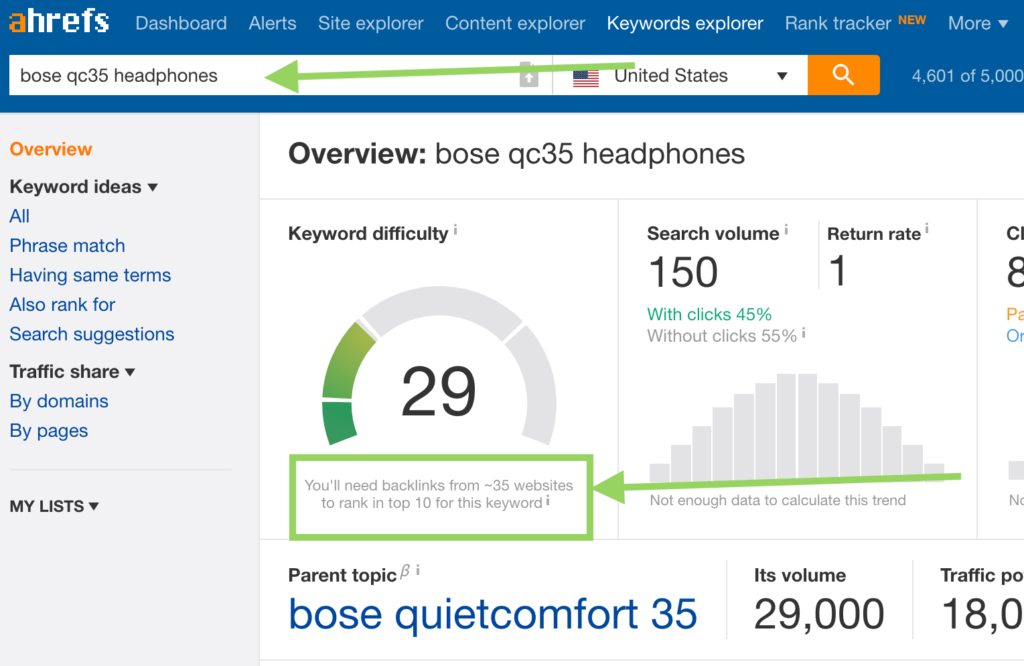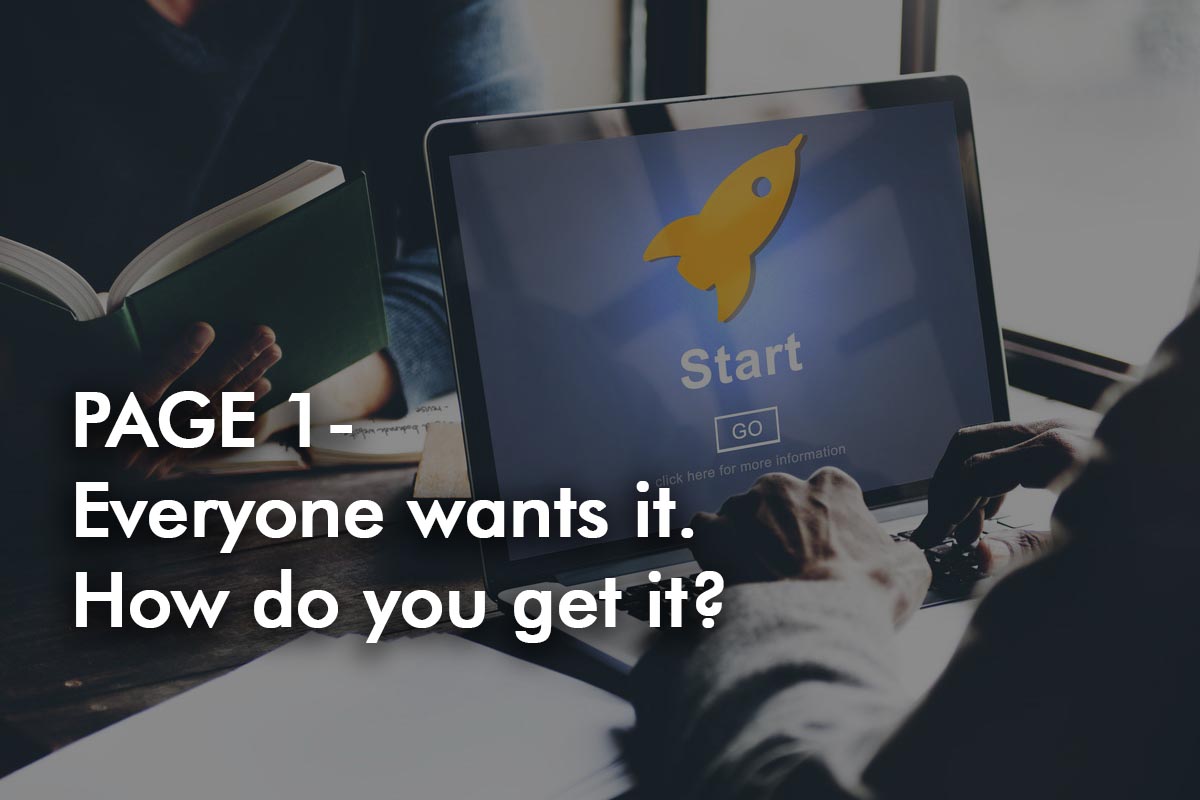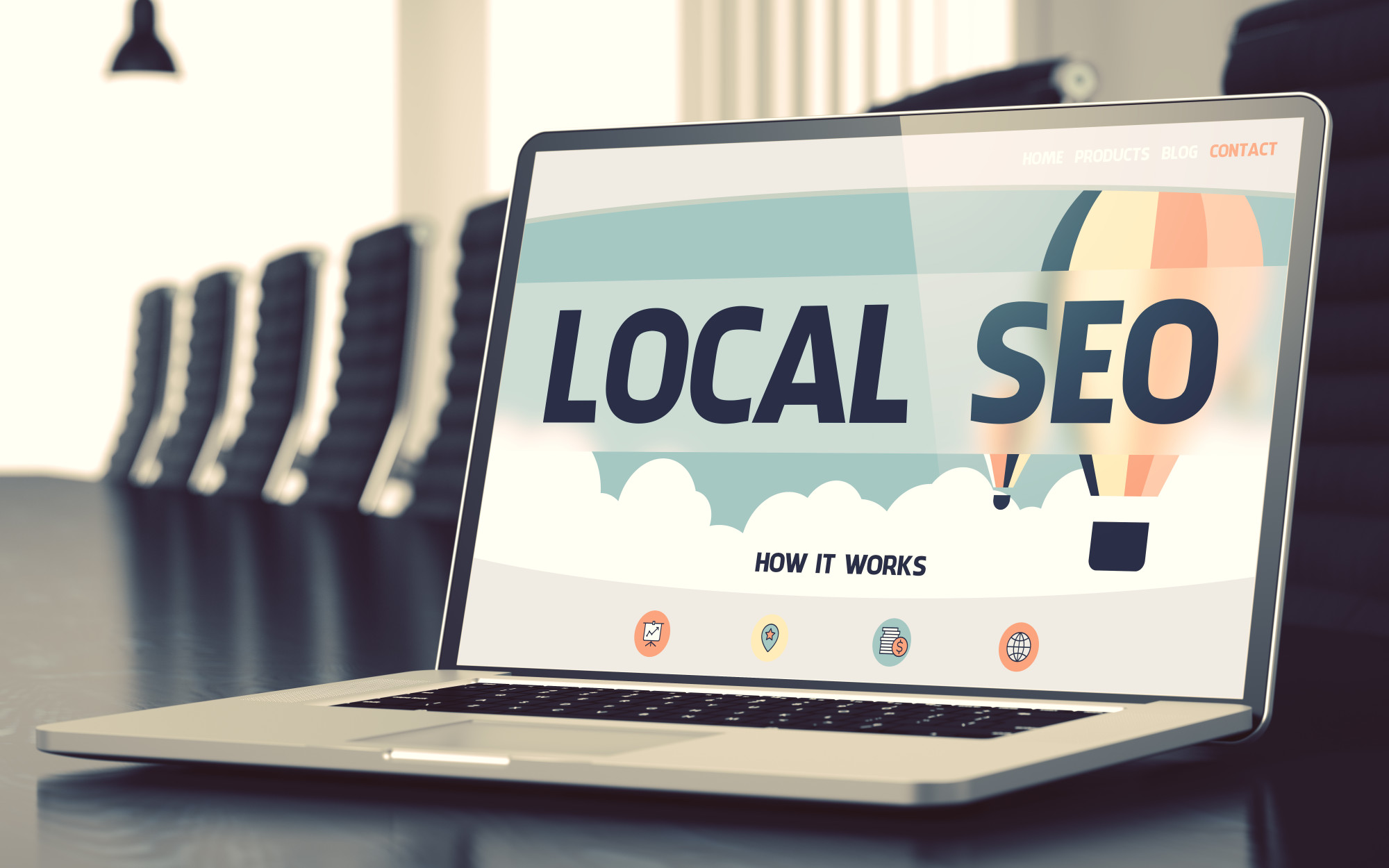The most asked question we get from every client is, “How much to get to the first page?”
We are going to be totally, brutally honest.
We don’t know… it depends.
Let’s get real. We aren’t going to bullshit you. There is no one way to find out how much it’ll take it to get to page 1 or the top listing. There are many influencing factors that affect your rank. Over 10,000 just on your site alone. There is so many factors that we don’t know 100% but we want to give you the best answer we can.
Let’s dive in!
What are the main ranking factors?
Back Links
Diversity of Back Links
Looking at the data we know that links to your website are very important.
A company called Ahrefs completed a study on ranking factors and the number of unique domains linking to a page is the single most important ranking factor.

(UR or “URL Rating” measures the strength of a target URL’s backlink profile and the likelihood that the URL will rank high in Google)
In short, the most important thing you can do to boost your page is build more quality links to that specific page you’re trying to target.
What makes a good backlink?
What is the Domain Authority or Domain Rating of the link?
When we say quality links, we look at the amount and quality of links coming to your website or specific page. It is important to take not of the authority the link holds.
The authority score is a measure of 0 to 100 on a logarithmic scale. This means the higher the score the harder it is to achieve.
Not all links are equal
When we begin doing an audit of a site, we can will often see a website with a million links but a low domain rating on the contrary we will also see sites with a few thousand links out ranking the site with a million links.
When Google did their Penguin update, they tried to get very particular with their algorithm and are trying to ignore links that have little to no value. This means that over time low quality links have or may get phased out.
It’s important to point out that just because there is a lot of links to a websites root domain (example: snapseo.ca and no slash after) doesn’t mean the website is going to win. Link authority, strength and context of the content on that page all matter.
Let’s talk about the content on the page you’re trying to rank.
Backlink Profile Enhancement
A meticulous examination of the backlink profiles for articles that currently outrank yours can unveil a roadmap to bolstering your own article’s authority. Should you discover that these pieces are fortified by links from esteemed and authoritative domains, it’s a signal to strategize a targeted outreach. The goal is to cultivate relationships and earn backlinks from these or comparable high-caliber websites. This not only enriches your backlink profile but also signals to search engines the credibility and trustworthiness of your content. Actively seek out and engage with platforms where your insights can contribute value, thereby meriting a backlink that reinforces your article’s standing in the competitive landscape of SEO.
How many backlinks do I need to be on the first page?
Here is a free way to estimate the amount of back links needs to get your website to the first page.
The first step is to go to Ahrefs Keyword Explorer.
From there type in the target keyword and an average number of links will be populated by Ahrefs.
In this example we are searching keywords for an eCommerce store but this practise remains true for any niche or keyword.

Adding you can search each ranking page and the number of domains.
You will likely notice that there is a gap between the number of links from all the listings on page 1. The reason is behind this is because it’s an average number of links.
Once we have this number it gives us an in site on how many links it would take to get us to page 1 or better yet – position zero.
What makes a quality link?
When building links, we look for quality, organically grow links. This means the website we put the link on is doing their own SEO to power their site.
Our favorite type of links are the ones we get from outreach blogging or guest posts as we like to call them. The problem is these take time and a lot of manual out reach and a lot of business do not have the time to write emails to sites that may not guarantee publiser placement.
Content and On-Page:
Search Intent
There is lots of factors but if your content doesn’t match the intent of a users search it will likely not rank, or have a much harder time ranking. How to quickly determine page intent:
- In Google search your target keyword.
- Pay attention to the top results
- If blog articles come up – write a blog article. If a sales page comes up – write a sale page.
Refining On-Page SEO for Maximum Impact
To ensure your article stands out in the digital landscape, a meticulous optimization of on-page elements is non-negotiable. Begin with the title tag—it should not only be enticing and reflective of the content but also woven with the right keywords to capture both the user’s interest and the search engine’s algorithms. It’s a delicate balance to strike, ensuring that it remains informative and relevant without tipping into keyword stuffing.
The meta description acts as your content’s billboard on the search engine results page. It should succinctly encapsulate the essence of your article while naturally integrating key phrases that potential readers are likely to search for. This snippet is your chance to make a compelling case for why a searcher should choose your article over others.
Headers within your article serve a dual purpose: they structure your content, making it easily digestible for readers, and they also offer SEO benefits when they include keywords relevant to the sections they preside over. However, their primary function is to guide the reader through the narrative of your content, so clarity should never be sacrificed for the sake of keyword density.
Lastly, scrutinize your URL structure, image alt-text, and any other on-page elements that can be optimized. URLs should be concise and indicative of the content’s subject matter, while alt-text for images should describe the image accurately and include pertinent keywords where appropriate.
By refining these on-page SEO elements, you’re not just ticking boxes for search engines; you’re enhancing the user experience, which is the cornerstone of modern SEO strategy.
Harmonizing Content with User Expectations
To resonate with your audience and search algorithms alike, it’s imperative that your article’s narrative is in harmony with the user’s search intent for the query of the users choice. Delve into the psyche of your readers: are they seeking a navigational roadmap, a compilation of tactics, or a thorough dissection of the topic? Your content should mirror these expectations with precision. By sculpting your article to reflect the sought-after format—whether it’s a sequential guide, a curated collection of methods, or a detailed exploration—you’ll be ensuring that your content not only attracts but also satisfies the informational cravings of your audience.
One way we look at this, is by looking at the first page of Google. We can take from the top three (3) ranking positions what Google believes is the best quality content. Google believes this is what users expect, thus an article should be written around this.
Remember: Searches update over time so keeping content fresh, and relevant is super important.
Content Depth – Expanding the Horizon of Your Content
It’s essential to benchmark your content against the more successful articles in your niche, ensuring that you’ve left no stone unturned. Scrutinize the landscape of top-ranking articles to identify the sub-topics they address—these are the gems your audience expects to discover. By weaving these sub-topics into the fabric of your article, you create a tapestry as rich and detailed as those at the pinnacle of search rankings. This comprehensive approach not only satisfies the user’s quest for information but also positions your content as a beacon of thoroughness and expertise.
Demonstrate Experience, Expertise and Authoritativeness:
In the realm of digital content, the authority conveyed by the author is as crucial as the content itself. To elevate your article’s trustworthiness and credibility, it’s vital to showcase the expertise of the author. This can be achieved by incorporating a detailed author bio that highlights their credentials, years of experience in the field of SEO, notable achievements, and any other elements that underscore their expertise. By presenting this information, readers can immediately gauge the reliability of the article and search engines can better understand the authoritativeness of the content source. A well-crafted author bio serves as a testament to the depth of knowledge and insight offered in the article, thereby enhancing its perceived value and influence.
Fortifying Your Site’s Internal Linking Framework
While this is partly technical SEO, and partly on-page, we are including this as an on-page factor. A robust internal linking strategy is the backbone of a well-structured website, serving as the arteries that guide both users and search engines to your content’s heart. To enhance your article’s visibility and authority, it’s essential to weave a network of internal links that not only supports navigation but also reinforces the thematic relevance of your content.
Start by identifying cornerstone content within your site—these are the high-authority pages that have already established their value in the eyes of search engines and users alike. Strategically link these pages to your article, ensuring that the linking is contextually relevant and provides additional value to the reader. This not only aids in transferring some of the established page’s authority to your article but also helps search engines in discovering and indexing your content more effectively.
Moreover, examine the anchor text used for these internal links. The anchor text should be natural and descriptive, providing clear indications about the content of the target page. This helps in reinforcing the topical signals to search engines, which can be beneficial for the SEO of both the linking and linked pages.
Don’t overlook the power of a well-placed internal link in newer or less trafficked content as well. By linking out from your article to other relevant pages, you create a reciprocal relationship that enhances the overall link ecosystem of your site. This interconnectivity not only improves user engagement by providing them with additional, relevant resources but also encourages a more thorough crawl of your site by search engines.
Remember, internal linking is not just about SEO; it’s about creating a user-centric navigation experience that logically connects different pieces of content across your website. By doing so, you encourage longer sessions, reduce bounce rates, and ultimately signal to search engines that your site is a rich, interconnected source of information.
Elevating Engagement Through Dynamic Content Formats
In the digital age, user engagement is the currency of content value. To captivate and retain the attention of your audience, your article must transcend traditional text and embrace a variety of content formats that cater to diverse preferences and learning styles.
Begin by assessing the landscape of your competitors’ content. If they are incorporating videos, it’s a clear indication that today’s users are seeking visual explanations and walkthroughs that offer a break from dense text. Consider producing succinct, informative videos that complement your written content. These can range from expert interviews to screen recordings that visually demonstrate SEO strategies in action.
Infographics are another powerful tool to distill complex information into digestible, visually appealing graphics. They serve as a quick reference point and are highly shareable, which can increase the reach of your content on social media and other platforms. By breaking down your article’s key points into an infographic, you provide a valuable resource that readers can easily consume and reference.
Interactive tools, such as quizzes, calculators, or SEO analysis tools, invite the user to engage directly with your content, offering a personalized experience. For instance, an interactive checklist for SEO best practices or a calculator for estimating the ROI of SEO investments can significantly increase the time users spend on your page, which is a positive signal to search engines.
Moreover, consider the layout and presentation of your content. Utilize well-spaced paragraphs, bullet points, and headers to improve readability. Interactive elements like collapsible sections or tabs can make navigating long-form content more user-friendly.
Lastly, encourage user interaction by ending your article with a call-to-action that prompts comments, questions, or shares. Engage with your readers by responding to comments and fostering a community around your content. This not only boosts engagement metrics but also builds a loyal readership that values your content as a two-way conversation.
By diversifying your content formats and encouraging active engagement, you not only enrich the user experience but also signal to search engines that your content is dynamic, relevant, and worthy of a higher ranking.
Technical optimization:
Mastering Mobile Optimization and Swift Load Times
In a world where mobile devices are the primary portals to the web, optimizing your article for these platforms is not just an enhancement; it’s a necessity. The mobile user experience is paramount, and it begins with ensuring that your page is responsive, adapting seamlessly to various screen sizes and orientations. This means that all elements of your page, from navigation menus to images and text, must be legible and accessible without the need for zooming or horizontal scrolling.
Beyond mere responsiveness, consider the tactile nature of mobile interaction. Touch-friendly design with appropriately sized buttons and links prevents the frustration of mis-taps and enhances the overall user experience. Additionally, mobile optimization includes the optimization of content layout, where paragraphs are concise and points are bulleted for ease of reading on smaller screens.
Loading speed is equally critical. A delay of mere seconds can lead to increased bounce rates and lost readership. Optimize images and videos to reduce their file size without compromising quality. Leverage browser caching, minify CSS, JavaScript, and HTML, and consider using a content delivery network (CDN) to speed up content distribution globally.
Furthermore, utilize tools like Google’s PageSpeed Insights to identify specific areas where your page’s loading speed can be improved. Implementing Accelerated Mobile Pages (AMP) can also offer a stripped-down version of your content that loads almost instantaneously for mobile users.
Note: Adding AMP pages often adds one more link to be indexed. Previously Google would weight AMP pages more heavily and rank them more, however this is no longer the case.
Remember, Google’s algorithms are increasingly mobile-first, meaning they predominantly use the mobile version of the content for indexing and ranking. A mobile-optimized page that loads swiftly is not just about providing convenience to users; it’s about securing your visibility in the search engine landscape.
By prioritizing mobile optimization and loading speed, you’re not only catering to the vast mobile audience but also aligning with search engines’ emphasis on mobile user experience, which can significantly bolster your article’s ranking potential.
Securing Trust with SSL/Encryption
In today’s digital landscape, where data breaches and privacy concerns are rampant, securing your website with SSL (Secure Sockets Layer) encryption is not just a best practice—it’s a trust signal to both users and search engines. SSL certificates create an encrypted connection between your web server and your visitors’ web browsers, ensuring that all data transmitted remains private and secure.
Implementing SSL encryption on your site does more than just protect your users’ data—it also contributes to the perception of your site as a credible and safe place to visit. Search engines like Google have openly acknowledged the importance of encryption, considering it a ranking signal. This means that having an SSL-secured site can give you an edge in search engine results pages (SERPs).
Here’s how you can ensure SSL/encryption is working for you:
-
Acquire and Install an SSL Certificate: If you haven’t already, obtain an SSL certificate from a reliable certificate authority (CA). Installation can typically be done through your hosting provider, and many offer free SSL certificates through Let’s Encrypt.
-
Enforce HTTPS: Once your SSL certificate is installed, make sure that your site is accessible exclusively over HTTPS by setting up proper redirects from HTTP to HTTPS. This ensures that users and search engines always access the secure version of your site.
-
Update Internal Links: Check your website’s internal links to ensure they use HTTPS URLs. This includes updating any hardcoded resources like images, scripts, and CSS files to use the HTTPS protocol.
-
Verify External Links: While you have less control over external sites, it’s good practice to ensure that any external links pointing to your site use HTTPS. Reach out to webmasters if necessary to update the URLs.
-
Use Secure Cookies: If your site uses cookies, set the ‘Secure’ attribute to ensure they’re only sent over HTTPS connections.
-
Monitor Your Security: Regularly check your site’s security status in your web browser and through tools like Google Search Console, which can alert you to any security issues.
-
Display Security Badges: If your SSL certificate comes with a trust seal or badge, display it prominently on your site to reassure visitors that their data is protected.
By prioritizing SSL/encryption, you’re not only enhancing your site’s security but also its SEO potential. Users are more likely to trust and engage with a site that shows it values their privacy and safety, leading to better engagement metrics and potentially higher search rankings.
Cultivating Social Proof and Nurturing Community Interaction
In the digital realm, the perception of your content’s value is often gauged by the social signals it generates. To elevate your article’s credibility and foster a sense of community, it’s essential to integrate elements that not only allow but also encourage reader interaction and engagement.
Initiate this by incorporating a comments section at the end of your article. This acts as an open invitation for readers to contribute their thoughts, ask questions, and offer insights, transforming your article from a static piece of content into a dynamic forum for discussion. To maximize the potential of this space, actively participate in these conversations. Respond to comments promptly, thank those who contribute, and engage in the dialogue. This not only humanizes your brand but also stimulates further interaction.
Social proof plays a pivotal role in reinforcing your article’s authority. Display social share counts prominently to highlight the community’s endorsement of your content. If your article has been shared by influencers or experts within the SEO community, make these endorsements visible. Testimonials, tweets, and public mentions by authoritative figures can serve as powerful indicators of your content’s value and reliability.
Moreover, consider integrating features that facilitate easy sharing of your content across social platforms. Social media buttons should be accessible and intuitive, allowing readers to spread the word with a single click. By lowering the barrier to sharing, you increase the likelihood of your content achieving wider circulation.
Don’t overlook the power of social media platforms themselves. Actively promote your article on your channels, and engage with users who comment or share your content. This not only drives traffic back to your article but also builds a narrative around your content that search engines can recognize as engagement signals.
By actively nurturing social proof and community engagement, you’re not just amplifying your content’s reach; you’re building a foundation of trust and authority that both users and search engines value. This, in turn, can lead to improved rankings and greater visibility in the digital ecosystem.
In Conclusion: Charting Your Course to the Summit of Search
The quest to secure a spot on Google’s illustrious first page is more than a mere goal—it’s a commitment to digital excellence. The journey is complex and requires a blend of strategic investment, unwavering patience, and a deep dive into the nuances of SEO. The “cost” transcends monetary value, embodying the time and expertise poured into every article, keyword, and link.
As we’ve unfolded the layers of search engine optimization, from meticulous on-page tactics to the art of earning authoritative backlinks, it’s evident that success in SEO is not an expense but an investment in your brand’s digital legacy.
Achieving this coveted position is a continuous endeavor, a balance of staying ahead of the ever-changing algorithms and remaining attuned to your audience’s needs. It’s about laying a foundation that’s built to last and grow in the ever-expanding digital universe.
As you stand at the crossroads, ready to elevate your online presence, remember that you don’t have to embark on this expedition alone. Our team is equipped with the expertise, tools, and passion to guide you through each step of the SEO journey.
Are you ready to climb to the top? Reach out to us. Together, we’ll craft a strategy that’s tailored to your unique path, ensuring that every step you take is measured, impactful, and geared towards that first-page summit.
🔗 https://snapseo.ca/contact-us/
Contact us today, and let’s turn your vision into a visible success.





